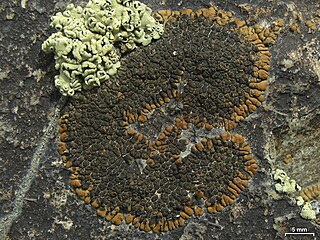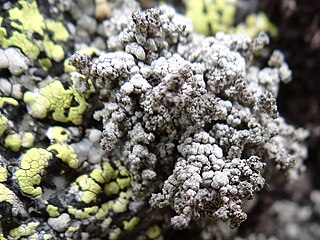
Sphaerellothecium is a genus of fungi in the family Phyllachoraceae. All of the species in the genus are lichenicolous, meaning they grow parasitically on lichens.
Endococcus is a genus of lichenicolous (lichen-dwelling) in the family Lichenotheliaceae. It has 44 species. The genus was circumscribed by the Finnish botanist William Nylander in 1855. Although at least one source places the genus in the Verrucariaceae, a 2016 study of the type species, Endococcus rugulosus, determined that it should instead be placed in the family Lichenotheliaceae of the order Dothideales; this classification echoes a placement proposed in 1979 by David Hawksworth.

Abrothallus is a genus of lichenicolous fungi. It is the only genus in the monotypic family Abrothallaceae, which itself is the sole taxon in the order Abrothallales.

Phacopsis is a genus of lichenicolous (lichen-dwelling) fungi. They are parasites of members of the large lichen family Parmeliaceae, of which they are also a member. Originally proposed by Edmond Tulasne in 1852 to contain 3 species, Phacopsis now contains 10 species, although historically, 33 taxa have been described in the genus. Many of the species are poorly known, some of them having been documented only from the type specimen.

Stereocaulon alpinum is a species of fungus belonging to the family Stereocaulaceae. It is similar to Stereocaulon paschale but differs from it in containing cyanobacteria of the genus Nostoc while S. paschale contains cyanobacteria of the genus Stigonema, which have a darker colour than Nostoc.

Sclerococcum is a genus of lichenicolous fungi in the family Dactylosporaceae.

Muellerella pygmaea is a species of lichenicolous fungus in the family Verrucariaceae. It has a cosmopolitan distribution in Arctic-alpine areas and grows on the thallus and apothecia of a number of hosts.
Neoechinodiscus kozhevnikovii is a species of lichenicolous (lichen-eating) fungus in the order Helotiales. It is known to occur in Russia, Austria, and Switzerland, where it grows parasitically on lichens in genus Cetraria.

Stereocaulon vesuvianum is a species of snow lichen belonging to the family Stereocaulaceae.

Stereocaulon saxatile is a species of snow lichen belonging to the family Stereocaulaceae.
Stereocaulon botryosum is a species of snow lichen belonging to the family Stereocaulaceae.
Stereocaulon glareosum is a species of snow lichen belonging to the family Stereocaulaceae.
Stereocaulon depressum is a species of snow lichen belonging to the family Stereocaulaceae.
Stereocaulon rivulorum is a species of snow lichen belonging to the family Stereocaulaceae.
Stereocaulon groenlandicum is a species of snow lichen belonging to the family Stereocaulaceae.
Lichenopeltella stereocaulorum is a species of lichenicolous fungus belonging to the class Dothideomycetes. It was described in 2010 from an infected specimen of Stereocaulon botryosum.
Cercidospora stereocaulorum is a species of lichenicolous fungus in the genus Cercidospora but it has not been assigned to a family. It is known to parasitise lichens of the genus Stereocaulon.
Sphaerellothecium araneosum is a species of lichenicolous fungus in the family Phyllachoraceae.
Arthonia stereocaulina is a species of lichenicolous fungus in the family Arthoniaceae.
Carbonea aggregantula is a species of lichen belonging to the family Lecanoraceae.







